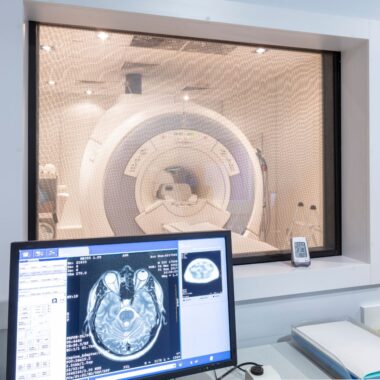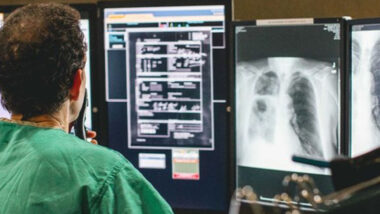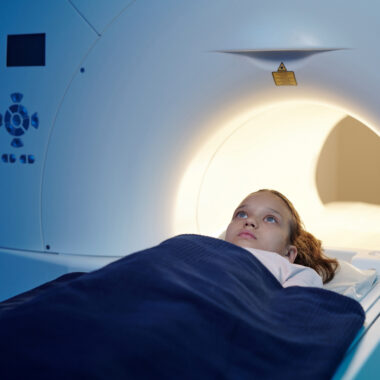How much do you know about diagnostic imaging? If your physician recommends an imaging scan, it’s important to know what kind of imaging you’ll be getting and why. Learn more about four major types of imaging, test your knowledge and find the right scan for your health needs.
Primary Diagnostic Imaging Services
- CT (computed tomography) — CT scans use advanced X-ray technology to create detailed images of the body from multiple angles, primarily the head, spine, chest or abdomen.
- MRI (magnetic resonance imaging) — MRI scans use radio waves to capture images of the body’s soft tissues including the brain, nerves, muscles, and other organs.
- X-ray — The oldest and most common form of imaging, X-rays use electromagnetic waves that pass through the body to create black and white images of dense material such as bone or metal.
- Ultrasound — Widely used, ultrasound imaging produces pictures of muscles, tendons, internal organs, and developing fetuses by using sound waves.
Test Your Imaging IQ: Round 1
Results
#1. True or False: X-rays and ultrasounds are the most widely used forms of medical imaging.
Answer: True. X-rays are the oldest form of medical imaging, and ultrasounds and X-rays are the most common forms of medical imaging.
#2. True or False: Ultrasounds use sound waves to take images of muscles and internal organs.
Answer: True. Physicians use ultrasounds to analyze muscles, tendons, internal organs, and developing fetuses.
#3. True or False: All four of the primary diagnostic imaging services are available at Charlotte Radiology.
Answer: True. CT scans, MRIs, X-rays, and ultrasounds are available through physician referral.
Read More: CT Scans: What to Know
Additional Diagnostic Imaging Services
- Fluoroscopy. Fluoroscopy uses an X-ray beam to create moving images on a computer to evaluate internal systems at work. Physicians also use fluoroscopy for guidance during medical procedures.
- Nuclear medicine imaging. Nuclear medicine imaging examines anatomical and bodily function. Before a body scan, patients ingest a contrast dye by mouth, intravenously or by inhalation. After, physicians use the imaging results to determine how the substance is distributed.
- Pediatric imaging. Charlotte radiologists are subspecialty trained to provide exceptional care to pediatric patients. Pediatric radiologists practice the “Image Gently” campaign to ensure the lowest radiation dose possible is used for pediatric imaging.
Test Your Imaging IQ: Round 2
Results
#1. True or False: Fluoroscopy requires you to drink a fluid to take a moving picture of the body.
Answer: False. Fluoroscopy creates moving images of bodily systems using X-ray beams.
#2. True or False: Nuclear medicine imaging looks at the body’s anatomy and function.
Answer: True. Nuclear medicine imaging uses a contrast dye to review the body’s internal structures.
#3. True or False: Charlotte Radiology practices “Image Gently” for all pediatric imaging.
Answer: True. Our radiologists are dedicated to the “Image Gently” campaign, which ensures the lowest radiation dose possible is administered during pediatric imaging services.
Conditions Imaging Scans Can Help Diagnose
Depending on your symptoms, lifestyle or medical history, your physician may order one or more of the following imaging scans to identify conditions from head to toe:
- CT scans — CT scans are used to diagnose various health conditions and screen for many forms of cancer including lung and colon cancer.
- MRI scans — MRIs don’t use ionizing radiation, making them safer for pregnant patients and infants. MRIs produce detailed images of ligaments, tendons, the spinal column, and more.
- X-rays — X-rays work best for bones and teeth.
- Ultrasound — Ultrasounds use soundwaves that are safer for pregnant women and infants. Ultrasounds are also ideal for vascular and other soft tissue conditions.
- Fluoroscopy — Used for a variety of conditions, fluoroscopy’s moving images are helpful in the treatment of nerve pain and several upper gastrointestinal exams.
- Nuclear medicine imaging — A frequently used form of nuclear medicine imaging is a positron emission tomography (PET) scan, used to detect cancer.
Read More: The Differences Between MRI and CT Scans
Test Your Imaging IQ: Rapid Round
Results
Congratulations — you’re an imaging ace! Here’s your extra credit. If your physician orders imaging scans, Carolinas Imaging Services, a joint venture between Charlotte Radiology and Atrium Health, provides convenient, affordable imaging, and is widely available in the Charlotte area.
#1. True or False: MRIs use a magnetic field that is considered safer for pregnant patients and infants.
Answer: True!
#2. True or False: PET scans are a form of nuclear medicine imaging.
Answer: True!
#3. True or False: MRI scans are the preferred exam for bones and teeth.
Answer: True!
Congratulations — you’re an imaging ace! Here’s your extra credit. If your physician orders imaging scans, Carolinas Imaging Services, a joint venture between Charlotte Radiology and Atrium Health, provides convenient, affordable imaging, and is widely available in the Charlotte area.
Request more information about our diagnostic imaging services.






